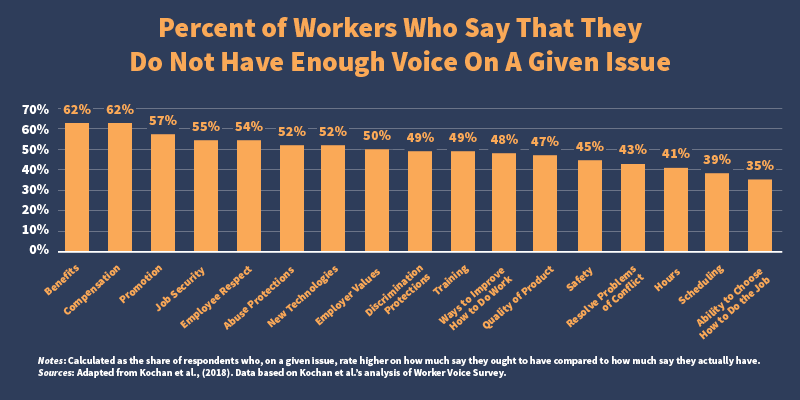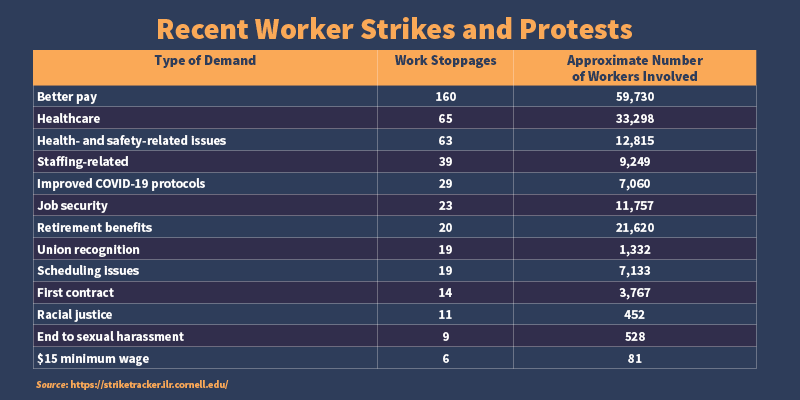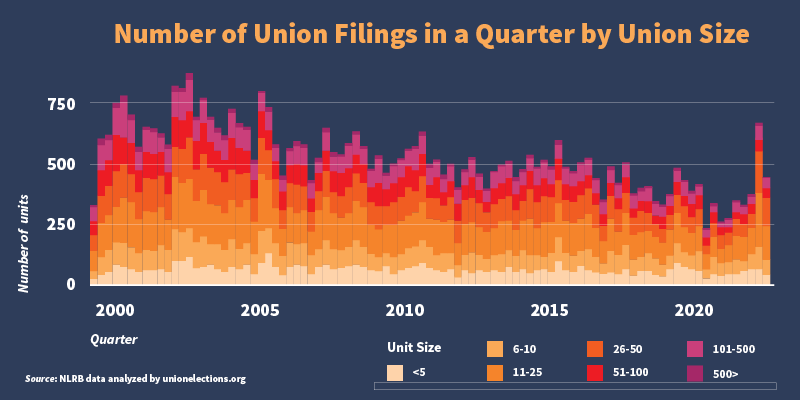Across the country, workers are organizing with their co-workers and engaging in collective action to gain improvements in their jobs and workplaces. What can we learn from these recent organizing efforts? How do they fit in the broader history of worker organizing in the United States? And how can the Department of Labor support worker organizing to advance our mission of improving working conditions for all workers?
To answer these questions, the department is collaborating with the Worker Empowerment Research Network, a group of leading labor researchers. The Network is conducting independent research on worker organizing and collective bargaining. Through this collaboration, the department can ensure that researchers understand the department’s work and priorities. Department employees will also evaluate and use new findings and insights about worker organizing and union representation to inform our own priorities, like supporting the work of the Task Force on Worker Organizing and Empowerment, chaired by Vice President Kamala Harris and vice chaired by Secretary of Labor Marty Walsh.
The Network research team has been pulling together a comprehensive picture of various forms of worker activism, taking stock of recent workplace organizing efforts and identifying their implications for workers and working conditions. Three data points in particular stand out from this work and tell the story about how workers lack the collective voice they want on the job — and how they’re translating that voice gap into new collective action and union organizing.
1. The wide voice gap at work: Drawing from a nationally representative survey of workers, the researchers summarized how large majorities of worker — well over half of workers for many issues — report a “voice gap” at work, meaning they have less say over working conditions than workers want.
As the figure below indicates, the workplace voice gap is especially large on some traditional workplace issues, like benefits, compensation, safety and promotion, but also extend to respect, protection against abuse and harassment, how technology is used and employers’ values. These survey results reveal that current workplace arrangements do not provide workers with the meaningful, collective voice they seek. The results echo the findings of other research showing millions of workers would choose union representation if given the chance, and particularly young workers and workers of color.

2. An increase in recent worker strikes and protests: Faced with the collective voice gap described above, many workers are engaging in strikes and protests across the country. The new Worker Empowerment Research Network report summarizes data from the Cornell Industrial and Labor Relations School Strike Tracker, which details strikes and protests in 2021 by the type of demand workers were making. The table demonstrates that while better pay and benefits were the most common issues leading to a strike or protest, many of the other causes or demands in 2021 reflected other issues that workers faced, including COVID-19 protections and other health and safety issues, staffing and scheduling.

3. The surge of new union elections: Not only are workers striking and protesting to gain greater collective voice over workplace issues, they are also filing petitions seeking formal union representation. In recent months we have seen a surge in the organizing of new units, as reflected in the figure below tallying new election filings and the number of workers participating in those elections. Representation election petitions at the National Labor Relations Board are up 57 percent from the same time period a year ago – a significant increase that shows workers’ interest in union representation. Understanding the causes and consequences of this increased organizing is important for the department given how important unions are for boosting worker voice and working conditions, especially for historically marginalized and excluded workers.

These three figures show how we can learn from data to improve our understanding of workers’ demand for a collective voice on the job – and how workers are translating that demand into concrete steps for collective representation.
At the department, we are eager to continue learning about important issues related to worker voice, organizing and representation from this collaboration to inform how we implement our mission, including through the Worker Organizing Task Force. Stay tuned for more articles on how new research is informing the department’s work. We will feature this research on DOL's forthcoming Worker Organizing Resource and Knowledge Center, a new online resource center for providing information to workers, employers, agencies, researchers, educators, students and others about unions, collective bargaining and worker organizing.
Alex Hertel-Fernandez is deputy assistant secretary for research and evaluation at the U.S. Department of Labor.
Lynn Rhinehart is senior counselor to Secretary Walsh at the U.S. Department of Labor.
| % workers who say that they do not have enough voice on a given issue | |
| Benefits | 62 |
| Compensation | 62 |
| Promotion | 57 |
| Job Security | 55 |
| Employee Respect | 54 |
| Abuse Protetions | 52 |
| New Technologies | 52 |
| Employer Voices | 50 |
| Discrimination Protections | 49 |
| Training | 49 |
| Ways to Improve How to Do Work | 48 |
| Quality of Product | 47 |
| Safety | 45 |
| Resolve Problems/Conflict | 43 |
| Hours | 41 |
| Scheduling | 39 |
| Ability to Choose How to Do the Job | 35 |
|
Type of Demand |
Work Stoppages |
Approximate Number of Workers Involved |
|
Better pay |
160 |
59,730 |
|
Health care |
65 |
33,298 |
|
Health- and safety-related issues |
63 |
12,815 |
|
Staffing-related |
39 |
9,249 |
|
Improved COVID-19 protocols |
29 |
7,060 |
|
Job security |
23 |
11,757 |
|
Retirement benefits |
20 |
21,620 |
|
Union recognition |
19 |
1,332 |
|
Scheduling issues |
19 |
7,133 |
|
First contract |
14 |
3,767 |
|
Racial justice |
11 |
452 |
|
End to sexual harassment |
9 |
528 |
|
$15 minimum wage |
6 |
81 |
| Quarter | Voters For | Voters Against | Units for | Units Against | Total Voters | Total Units |
| 4/1/2000 | 26,964 | 37,699 | 420 | 419 | 64,663 | 839 |
| 7/1/2000 | 21,707 | 29,218 | 332 | 324 | 50,925 | 656 |
| 10/1/2000 | 21,310 | 27,568 | 337 | 327 | 48,878 | 664 |
| 1/1/2001 | 13,619 | 26,400 | 288 | 264 | 40,019 | 552 |
| 4/1/2001 | 17,742 | 31,020 | 346 | 309 | 48,762 | 655 |
| 7/1/2001 | 13,950 | 38,171 | 319 | 278 | 52,121 | 597 |
| 10/1/2001 | 17,013 | 28,069 | 278 | 280 | 45,082 | 558 |
| 1/1/2002 | 11,171 | 20,341 | 267 | 237 | 31,512 | 504 |
| 4/1/2002 | 24,271 | 27,028 | 380 | 291 | 51,299 | 671 |
| 7/1/2002 | 14,362 | 24,499 | 360 | 298 | 38,861 | 658 |
| 10/1/2002 | 16,794 | 37,213 | 328 | 304 | 54,007 | 632 |
| 1/1/2003 | 12,049 | 16,063 | 263 | 205 | 28,112 | 468 |
| 4/1/2003 | 17,642 | 19,023 | 364 | 272 | 36,665 | 636 |
| 7/1/2003 | 14,724 | 14,333 | 316 | 222 | 29,057 | 538 |
| 10/1/2003 | 14,229 | 18,812 | 270 | 224 | 33,041 | 494 |
| 1/1/2004 | 16,312 | 17,479 | 250 | 225 | 33,791 | 475 |
| 4/1/2004 | 20,177 | 21,018 | 354 | 265 | 41,195 | 619 |
| 7/1/2004 | 14,107 | 21,622 | 316 | 230 | 35,729 | 546 |
| 10/1/2004 | 11,975 | 18,175 | 276 | 207 | 30,150 | 483 |
| 1/1/2005 | 11,654 | 15,990 | 269 | 190 | 27,644 | 459 |
| 4/1/2005 | 17,444 | 22,835 | 391 | 220 | 40,279 | 611 |
| 7/1/2005 | 13,505 | 13,582 | 252 | 187 | 27,087 | 439 |
| 10/1/2005 | 8,707 | 9,685 | 258 | 159 | 18,392 | 417 |
| 1/1/2006 | 13,230 | 11,972 | 210 | 140 | 25,202 | 350 |
| 4/1/2006 | 12,490 | 17,309 | 250 | 153 | 29,799 | 403 |
| 7/1/2006 | 9,006 | 10,052 | 224 | 161 | 19,058 | 385 |
| 10/1/2006 | 14,679 | 10,087 | 215 | 137 | 24,766 | 352 |
| 1/1/2007 | 10,150 | 9,273 | 181 | 135 | 19,423 | 316 |
| 4/1/2007 | 11,122 | 13,012 | 225 | 182 | 24,134 | 407 |
| 7/1/2007 | 12,087 | 10,039 | 208 | 141 | 22,126 | 349 |
| 10/1/2007 | 13,516 | 11,820 | 212 | 155 | 25,336 | 367 |
| 1/1/2008 | 12,925 | 6,415 | 225 | 110 | 19,340 | 335 |
| 4/1/2008 | 19,765 | 14,721 | 288 | 178 | 34,486 | 466 |
| 7/1/2008 | 10,861 | 10,068 | 225 | 141 | 20,929 | 366 |
| 10/1/2008 | 17,697 | 9,330 | 246 | 130 | 27,027 | 376 |
| 1/1/2009 | 7,393 | 4,767 | 189 | 87 | 12,160 | 276 |
| 4/1/2009 | 12,941 | 5,121 | 207 | 96 | 18,062 | 303 |
| 7/1/2009 | 8,305 | 7,965 | 189 | 103 | 16,270 | 292 |
| 10/1/2009 | 12,235 | 7,254 | 232 | 142 | 19,489 | 374 |
| 1/1/2010 | 9,517 | 9,674 | 225 | 116 | 19,191 | 341 |
| 4/1/2010 | 16,701 | 7,815 | 292 | 140 | 24,516 | 432 |
| 7/1/2010 | 16,613 | 8,854 | 262 | 140 | 25,467 | 402 |
| 10/1/2010 | 17,074 | 12,892 | 255 | 177 | 29,966 | 432 |
| 1/1/2011 | 12,321 | 5,736 | 193 | 91 | 18,057 | 284 |
| 4/1/2011 | 9,700 | 10,113 | 192 | 121 | 19,813 | 313 |
| 7/1/2011 | 10,916 | 6,869 | 175 | 93 | 17,785 | 268 |
| 10/1/2011 | 13,976 | 8,617 | 205 | 114 | 22,593 | 319 |
| 1/1/2012 | 10,360 | 8,186 | 179 | 123 | 18,546 | 302 |
| 4/1/2012 | 10,610 | 11,278 | 209 | 124 | 21,888 | 333 |
| 7/1/2012 | 8,959 | 7,391 | 194 | 112 | 16,350 | 306 |
| 10/1/2012 | 7,653 | 8,217 | 181 | 124 | 15,870 | 305 |
| 1/1/2013 | 6,689 | 5,478 | 174 | 83 | 12,167 | 257 |
| 4/1/2013 | 10,794 | 12,272 | 224 | 134 | 23,066 | 358 |
| 7/1/2013 | 9,829 | 8,146 | 199 | 126 | 17,975 | 325 |
| 10/1/2013 | 9,947 | 9,227 | 219 | 117 | 19,174 | 336 |
| 1/1/2014 | 7,414 | 7,884 | 173 | 93 | 15,298 | 266 |
| 4/1/2014 | 13,232 | 6,759 | 254 | 116 | 19,991 | 370 |
| 7/1/2014 | 9,385 | 7,818 | 227 | 107 | 17,203 | 334 |
| 10/1/2014 | 14,246 | 9,049 | 244 | 123 | 23,295 | 367 |
| 1/1/2015 | 9,389 | 8,805 | 222 | 100 | 18,194 | 322 |
| 4/1/2015 | 15,527 | 13,379 | 311 | 154 | 28,906 | 465 |
| 7/1/2015 | 12,453 | 6,686 | 234 | 121 | 19,139 | 355 |
| 10/1/2015 | 10,835 | 7,435 | 223 | 115 | 18,270 | 338 |
| 1/1/2016 | 13,091 | 7,079 | 230 | 101 | 20,170 | 331 |
| 4/1/2016 | 15,011 | 6,166 | 258 | 99 | 21,177 | 357 |
| 7/1/2016 | 10,056 | 6,568 | 220 | 89 | 16,624 | 309 |
| 10/1/2016 | 13,657 | 7,354 | 185 | 103 | 21,011 | 288 |
| 1/1/2017 | 10,230 | 11,454 | 197 | 115 | 21,684 | 312 |
| 4/1/2017 | 11,805 | 9,931 | 246 | 92 | 21,736 | 338 |
| 7/1/2017 | 11,331 | 10,275 | 247 | 102 | 21,606 | 349 |
| 10/1/2017 | 11,341 | 9,871 | 208 | 92 | 21,212 | 300 |
| 1/1/2018 | 7,493 | 5,567 | 179 | 91 | 13,060 | 270 |
| 4/1/2018 | 17,965 | 6,512 | 205 | 99 | 24,477 | 304 |
| 7/1/2018 | 5,399 | 4,226 | 148 | 64 | 9,625 | 212 |
| 10/1/2018 | 12,764 | 7,968 | 176 | 76 | 20,732 | 252 |
| 1/1/2019 | 8,555 | 4,797 | 178 | 55 | 13,352 | 233 |
| 4/1/2019 | 12,374 | 6,235 | 237 | 87 | 18,609 | 324 |
| 7/1/2019 | 9,963 | 5,672 | 217 | 90 | 15,635 | 307 |
| 10/1/2019 | 12,460 | 5,657 | 223 | 76 | 18,117 | 299 |
| 1/1/2020 | 5,398 | 3,659 | 141 | 66 | 9,057 | 207 |
| 4/1/2020 | 4,408 | 2,701 | 100 | 32 | 7,109 | 132 |
| 7/1/2020 | 8,253 | 5,236 | 148 | 81 | 13,489 | 229 |
| 10/1/2020 | 8,456 | 7,408 | 144 | 85 | 15,864 | 229 |
| 1/1/2021 | 5,723 | 2,446 | 126 | 52 | 8,169 | 178 |
| 4/1/2021 | 10,218 | 4,395 | 179 | 79 | 14,613 | 258 |
| 7/1/2021 | 5,974 | 3,574 | 144 | 76 | 9,548 | 220 |
| 10/1/2021 | 6,389 | 5,917 | 172 | 84 | 12,306 | 256 |
| 1/1/2022 | 5,820 | 10,824 | 150 | 100 | 16,644 | 250 |
| 4/1/2022 | 9,419 | 17,207 | 178 | 148 | 26,626 | 326 |

 U.S. Department of Labor Blog
U.S. Department of Labor Blog
